Reptile & Amphibian
News Blog
Keep up with news and features of interest to the reptile and amphibian community on the kingsnake.com blog. We cover breaking stories from the mainstream and scientific media, user-submitted photos and videos, and feature articles and photos by Jeff Barringer, Richard Bartlett, and other herpetologists and herpetoculturists.
Wednesday, August 31 2011
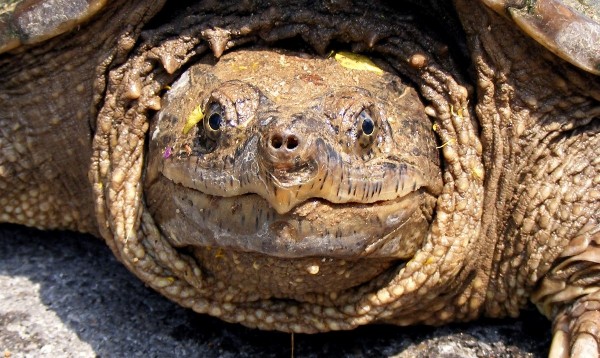 There aren't too many things that unite the herp and animal rights communities, so maybe we ought to give "Snapperfest" in Ohio County, Indiana, some kind of award. On second thought, an "award" isn't what I'd like to give them.
The event has been going on for 15 years, so the organizers were surprised to be met with so much opposition this year.
The contest involves fishing a turtle out of a tank filled with murky water. Contestants use only their hands to try to pull the animal's head out of its shell. The goal is to get a hand around the turtle's neck without getting bit.
[....]
Snapperfest has the blessing of local law enforcement as well as conservation officers. Tom Chalk's been around since the whole thing started. "There ain't no abuse to the turtles whatsoever...there's never been one slammed or killed or had its head ripped off."
What's amazed everyone at the campground is all the attention the event has suddenly received. "We've had calls from Germany, Canada...Florida...every state in the United States has called. The phone it just rings off the handle. Some people get real nasty, cuss us out. We just hang up. We just try to explain what's going on, it's not abuse."
Two very different videos are being circulated. One is the news report featuring the above comments, which can be found here. The other, a video from an attendee last year, can be seen after the bump.
Watching both, really, is there any wonder why animal lovers are outraged?
Continue reading "'Snapperfest' celebrates animal abuse"
Tuesday, August 30 2011
By
Tue, August 30 2011 at 21:38
How much is that alligator in the window?
By: Chris Law
Saltwater Crocodile (Crocodylus porosus)- Photo by the author
The title of this article might seem a bit silly, however, this question is asked in pet stores across the nation much more often than one might think.
There are many people throughout the world who question the sanity of any individual who has any admiration for these prehistoric reptiles, much less an individual who wants to keep one as a “companion animal” in their dwelling. The biggest problem today, is that pet alligators and other crocodilians such as caimans and crocodiles are becoming increasingly popular. The popularity boom in pet crocodilians is a direct result of cheap prices, easy access and smooth sales pitches from pet store owners/employees which is often-times misinformation on care and proper accommodation. At this point, you are probably curious about the inaccuracies in these statements and what makes them false. It is only natural that potential owners be curious and skeptical of new information, beyond what they were told by, whom they felt, were experts on the topic.
Some of these commonly used sales pitches are:
- Crocodilians only grow to the size of their enclosure
- Limiting the animals feeding will limit the animals growth
- Regular handling will tame the animal and make them more suitable pets
- Goldfish make for good crocodilian food
- Crocodilians don’t require veterinary care
These kinds of sales hype are used by a large number of pet stores, because this approach is often known to end with a sale. This article will attempt to cover each statement as thoroughly as it can to help provide you a better understanding as to why these statements are used and why they are false.
1.) Crocodilians only grow to the size of their environment. - Pet stores use this statement because this gives the potential purchaser a false sense that they will always be able to manage this animal. Presumably, first time potential purchasers consider housing accommodations first before bringing the prospective pet home. By a believed “expert” on these animals informing them that these animals’ size can be controlled, it relieves this concern of the purchaser. However, a potential purchaser should not assume that the seller is an “expert” on these animals.
Truth- Crocodilians, along with other reptiles, grow according to Caloric intake and temperature. Reptiles, after capturing their prey and ingesting it, utilize their environmental temperature, along with their strong stomach acids to aid in the digestion of the food item. If appropriately warm temperatures and a constant food supply are provided (as it should be) these animals will continue to outgrow enclosure upgrades, until they reach adulthood.
2.) If you reduce food intake, it will limit the animal’s growth- Once again, this is used to give a purchaser a false sense of control over this animal’s size and over-all growth. This statement is actually true, but not quite in the manner you might think.
Truth- While this statement is actually true; its practice is unethical as well as unhealthy for the animal in question. All crocodilians grow and develop for their entire lifespan. As with all other animals in the Wild Kingdom, crocodilians and other reptiles require specialized diets in appropriate quantities in order to support its development. Lack of appropriate diet in sufficient quantities can lead to poor muscle tone and bone deformities (among other ailments) due to a severe calcium deficiency. It is imperative that you thoroughly research the correct nutritional requirements for crocodilians (or any animal for that matter) before bringing it into your dwelling. Beyond the health factors associated with this practice, it is ethically questionable. Just as a parent would want to ensure proper nutrition for their child, a pet owner owes it to the animal to have the same.
3.) Regular handling will tame your Alligator and make it a more suitable pet in your home. – Obviously, another concern among most purchasers of these animals is the risk of injury due to the animal’s powerful jaws and lacerating teeth. Many buyers purchase a crocodilian thinking they can condition the animal to behave like a dog. Presuming that frequent handling will tame the animal gives the impression that the animal will be fully controllable and easy to manage.
Truth- It is no surprise that some handling is unavoidable. There is routine maintenance to keep in mind as well as veterinary procedures that might at some point require the handling and restraint of your crocodilian. However, these handling sessions should be only on an “as needed” basis and only long enough to perform these functions and then the animal should remain undisturbed for the remainder of the time. During handling sessions, proper physical support should be provided to the animal to prevent injury to the animal or keeper, even if this requires an additional person to get the job done correctly. Routine handling will only help the animal to build some “tolerance” for it. However, it is important to note that “tolerance” does not equate to “enjoyment”. Crocodilians, in general do not enjoy being handled, as it is unnatural and can be a rather stressful experience for it. Most animals upon being grasped will proceed to thrash and struggle. This struggle causes a build-up of lactic acid in the bloodstream which in most cases causes the animal to become tired; however, too great an increase of this build-up can be fatal. A result of the general newness and uniqueness of such animals as pets, is that they are frequently handled upon purchase. However, the comfort and security of the animal must be taken into consideration and thus generally means frequent handling should be avoided for the well being of the specimen in question.
In the hands of professionals with proper care, limited handling and a rotation of animals to be used, stress on individual specimens is minimized. There are cases where sometimes crocodilians are used for entertainment or educational purposes where they are being physically restrained or handled in a manner that causes the animal to become stressed. In general, when this is the case, it is best to have 2-3 additional animals to use so that that they may all be cycled in/out of the show or program to prevent too much stress on one animal. Limited handling is always the best policy. This reduces stress to the animal and reduces chances of physical injury to the animal or keeper.
Flavio Morrissiey of reptilebehavior.com, a specialist in reptile behavior, states, “Health issues are typically anorexia and infections from stress. Each animal responds differently to handling. Handling is defined in my terms as touching, using foreign objects to move the animal (stick, rope, hook etc.).”
Chris Dieter, director of Crocodile Encounters in Angleton, Texas says, “Up to about 2 years of age limited handling doesn't adversely affect them at all. However excessive handling appears to increase the animal’s stress, slows growth and diminishes overall health. After 2 years virtually all handling is stressful”.
4.) Goldfish (Carassius auratus) are a good staple diet for hatchling crocodilians.- Pet owners want simplicity, not complexity. Throwing common goldfish to the animals seems to be an easy way to feed it.
Truth- There is little nutritional value in goldfish. Raising a crocodilian on goldfish would be about the equivalent of a parent raising their child on junk food. Goldfish simply do not provide adequate nutrition that would help your young animal to develop into a strong, healthy adulthood.
As a hatchling, Rosy red feeder fish, crickets, fuzzy mice, chicken and beef among other food items make a good staple diet for a young crocodilian. When it comes to captive crocodilian diet- variety is the key. If you are not feeding whole prey items (as in whole rodents, chickens, etc) then likely the animal is not satisfying its nutritional needs. Hence, vitamin and mineral supplementation is very necessary. In addition to this, goldfish are known to carry a harmful enzyme known as ‘Thiaminase’. To make a long story short, Thiaminase destroys Thiamine which is Vitamin B1. A staple diet of goldfish will lead to the malnourishment and death of your animal. Simply put, your animal should never see a goldfish.
Crocodilians never have to be taken to a vet because they are a reptile. – What else could make a pet alligator or other crocodilian seem even more ‘low maintenance’ than never having to receive veterinary attention? No wonder pet sales agents may say this. If a potential crocodilian purchaser feels that they can spend less money, but can still have a pet to brag about to their friends, this animal will sell. Many pet stores will use this as an additional ‘perk’ to owning one of these animals. No trips to the vet office, means less money spent. This makes these animals seem even more attractive to own.
Truth- While crocodilians seldom require veterinary care if kept in proper conditions and provided an excellent diet, this alone doesn’t mean that a trip to the vet’s office will never be needed. Improper temperature and humidity levels will lead to a serious respiratory infection. Unsanitary conditions could result in a bacterial infection.
Photos courtesy of Shane Heck- Rescued American Alligator w/ bacterial infection
There are other issues to keep in mind as well for the health of these animals, but the two listed are most common. Crocodilians are far more complex, biologically and physiologically, than what meets the eye. It is automatically assumed that they are reptiles and carry all the same basic needs and requirements of other reptiles. However, it’s not as simple as that. Crocodilians, being evolved on this planet for approximately 200 million years, have a variety of biological and physiological adaptations that are not anything reptilian-like. In all rights, these animals are a mixture of many of our world’s animal inhabitants, and are more closely related to birds than reptiles.
Still interested in keeping a pet crocodilian? Please, read further…
Let’s get down to brass tacks. The housing of a hatchling seems pretty inexpensive, right? Have you thought about what it would cost to house this animal properly 3-4 years from now? How about as an adult? What do the experts say about the economics of keeping a crocodilian in a private capacity?
“The keeping of a large crocodilian is not an inexpensive endeavor”, says Judith Bryja, Supervisor of Herpetology for the Houston Zoo. “Presuming one has the space and no restrictions disallowing the keeping of the animal, it is a big project to provide an environment with clean water and a secure containment system,” said Bryja. Most would also require some type of heating. I won’t guess on the cost of initial setup but it would not be cheap. Food would probably run about $100.00 per month. Veterinary care would be a challenge and quite expensive.”
Things to consider when deciding upon keeping a pet crocodilian:
1.) Currently, I have a 12 inch American Alligator, but what do I plan to do when this animal is 8,9,10 feet or larger?- Keeping possession of these animals when they are young animals 1-2ft seems easy enough. You might even be successful housing and keeping it at 3-4ft. However, you can’t ignore the fact that the animal WILL get larger if it is properly cared for. What do you plan to do then? Let it free-roam around the home, only to cause you or one of your family members a severe injury because of a simple accident? You must keep ALL life-stages of these animals in mind before deciding whether you want to take upon the responsibility of keeping one in your home.
2.) Is the animal legal where I reside?- Some states have legal restrictions on possession of such animals. Even if the state doesn’t, your local laws pertaining to your city, county, or township will most likely have some sort of laws restricting the ownership of certain animals. In most cases, these are due to houses being too close together and high population of children in the area, etc. What if the animal were to escape its enclosure somehow and get loose into the neighborhood? This most certainly is not unheard of.
3.) Will I have the financial stability to care for this animal when it is an adult?- You may have the space to house this animal as an adult and be completely willing to do so, but there might be ONE thing getting in your way…your wallet. If you are barely able to pay your current bills now and you are living off of the basics with no luxury items to get rid of, then most likely you are going to have a terrible time providing for your animal. Think of the frequent water changes, electric for heating, and food bills. A large enclosure requires a lot more heat, which costs a lot more to provide. A larger animal eats considerably more than that 20” animal you have now. If you can’t afford to provide everything that the animal needs, the animal only suffers.
4.) How do those living with and/or around me feel about this? – It’s simple enough to say, “The heck with what my neighbors think, this is a free country”! The problem with this is that your neighbors are concerned about their own safety. Again, what if your animal escapes and meets them on their doorstep one morning? You don’t really think you’re going to keep a 10’ Alligator inside the house do you? Usually, nobody frets about the hatchling you just brought home, but as this animal grows, it will create a greater concern. What about your family living with you? Could this possibly cause a strain on a marriage? If so, you’re only going to have to find another home for this animal anyhow (unless of course you don’t mind forfeiting your marriage for this animal) so why bother to get one if you can’t provide for it for the rest of its life?
5.) Am I willing to risk serious injury or even death for the sake of having an interesting or cool pet?- People are often under the assumption that they will tame this animal down so that it is basically a scaly puppy dog. The fact of the matter is that no matter how “tame” this animal seems, it is still a wild animal with wild instincts that you could unintentionally trigger. This could easily result in the loss of a limb or extremity.
6.) Are you currently living in the north or south?- If you are living in the northern U.S. housing this animal is going to be much more difficult. The winters are MUCH harsher and housing outdoors is rather difficult unless you happen to build a barn or something similar that is heated and insulated. The construction of such a building will run thousands of dollars and the maintaining of that building will be expensive as well. Again, remember heating, water filtration, water changes, basking bulbs or other forms of lighting. Some of these aren’t necessarily expensive standing alone, but all together it certainly adds up.
7.) Are you living in a house or apartment?- If you’re living in an apartment, why are you even considering this? Do you know for 150% certain that you are moving out of that apartment within the next couple of months and into a house that you own? This goes the same for renting a house. Renting isn’t going to do you any good as you can’t build anything permanent for the animal. You should only be considering this IF, you are stable in your living environment.
8.) Do you have a veterinarian that can treat your crocodilian if the need arises?- If not, you better find one. You never know when your animal might need some medical treatment. What if the power in your house goes out for a few days and the temperature drops to a dangerous level and the animal develops a respiratory infection? In many cases, this can be corrected simply by correcting the environmental conditions. However, sometimes, the infection is developed enough that it requires medical treatment to resolve via the use of antibiotics. Who is willing to do this in your area? You just can’t waltz into any veterinary clinic and check your Nile Crocodile in for a checkup! If you are curious about where you can find a crocodilian vet, please see: http://www.crocodopolis.net/directoryvetr.htm
9.) What about transportation of a large adult animal?- If you think you’re going to load your 10’ Nile crocodile into your 2-door Chevy Cavalier, think again! A large truck, even an F-150 would do the trick, but what about during the winter time? This might seem easy enough to resolve, but it still requires consideration as if you’re not already driving such a vehicle, you would be required to buy one just because of your “pet”.
10.) Do you have a backup handler for safety?- Do you honestly think that you’re going to be able to handle this animal all on your own? It’s easy enough to do up to around 4-5’. After that, it gets a little tougher. It’s more difficult to physically restrain the animal and when carrying the animal, you run the risk of not properly supporting the animals’ weight and causing injury to the specimen in question.
Would you seriously want to take your chances handling this on your own? – Photo by the author
“If I’ve decided that crocodilian ownership is not for me, however, I do want to have opportunities to work with them…what can I do”?
That is certainly a good question. After all, animals across the globe need all of the help they can get. Someone such as you would be an excellent asset. Perhaps the first thing that must be considered is exactly how far do you want to take your interaction opportunities? Are you interested in just a part time interaction, a few times per week or are you considering a zoological career related initiative? Zoos at times are looking for keepers if you’re willing to put in the volunteer time or get a degree. For many zoos, both would be a requirement.
Rescues and rehabilitation centers many times need volunteers to help with cleaning, feeding, and sometimes educational outreach programs. Does any of this sound like something you would be interested in? If so, please check out: http://www.crocodopolis.net/directoryemploy.htm for a list of web sources that can help you figure out how to get started in a career with crocodilians and other exotic wildlife. It is understandable why some feel the desire to keep certain animals within their possession, but it is without a doubt that in many regards it is not to the animals’ benefit. Please educate yourself well before undertaking the challenge of keeping a dangerous predator.
 The reptile community has been losing many of its pioneering members recently. We lost a giant when, only a few days short of the age of 92, Dr. Findlay Ewing Russell passed away:
Dr. Russell leaves behind an extraordinary legacy in science, particularly in the fields of toxicology and toxinology. If he could, he would continue to explore and expand the knowledge and work in this field which began in the 1950s at Caltech and continued at USC where he served as the Director of the Laboratory of Neurological Research in Los Angeles.
Findlay received his medical degree from Loma Linda University in 1952 and worked as a physician and neurosurgeon until war wounds restricted his dexterity. He had served as an army medic in World War II in the Okinawa Campaign where he received a Purple Heart and two Bronze Stars.
Findlay was the first president and founding member of the International Society of Toxinology (Toxicon) and continued throughout his life to support the study of toxins and venomous animals. He is recognized as one of the pioneering scientists to progress polyvalent crotalid antivenom for the use of snakebite envenomation.
Findlay served as a professor of neurology, physiology and biology at USC for over 30 years. He was the author of numerous scientific articles, books and holds several patents in the field of medicine. Several species of arachnids are named after him.
In addition to his medical degree, he held a PhD in English and was awarded an honorary degree in law from the University of Santa Barbara. Dr. Russell was a Fulbright scholar and was a visiting professor to numerous colleges and universities throughout the world, including Cambridge (England), Stefan Institute (Yugoslavia), University of Argentina (Buenos Aires) and the University of Cairo (Egypt).
In 1974 Findlay was awarded the Skylab Achievement award for his work with NASA. In addition, Fin consulted for the World Health Organization, Doctors Without Borders and National Science foundation. Findlay received numerous awards and distinguished acknowledgments from his peers, most recently he was awarded the Loma Linda University Alumnus of the Year (2011) in California and the Findlay E. Russell Distinguished Citizen Award from the College of Pharmacology at the University of Arizona. For the last 15 years he worked at the School of Pharmacology at the University of Arizona where he leaves many colleagues and friends.
Condolences can be sent to the Russell family, 25611 N. Moon Blossom Ln., Phoenix, AZ 85083. Remembrances can be made in his name to the Portal Fire and Rescue Station, Box 16331, Portal, Arizona, 85632.
Saturday, August 27 2011
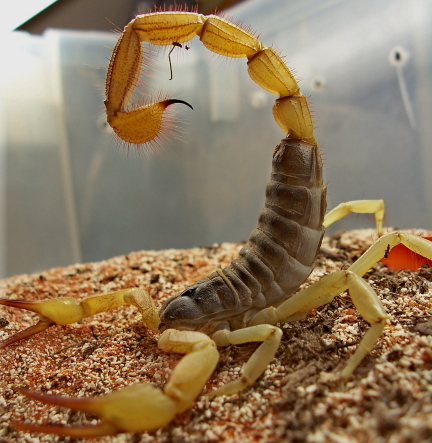 While not deadly, the sting from a scorpion can be amazingly painful, causing more severe issues in children, who are the most commonly stung. But that is all changing thanks to groundbreaking research by Leslie Boyer and her team.
"Without antivenom, if you've got that bad of a sting, you accept intensive care or you risk death," says Dr. Leslie Boyer, a pediatrician who directs a venom research center in Tucson.
Drug companies in the U.S. have little incentive to make antivenom, because it's expensive and there simply aren't enough patients to guarantee a profit. "We in Arizona felt very isolated; we felt abandoned," Boyer says. "This was an orphan disease."
That was until Boyer took a trip south of the border and discovered that Mexico has a far bigger scorpion problem.
In Mexico, a quarter of a million people are stung by scorpions each year. Some clinics in central Mexico can have dozens of scorpion sting patients per night in the summer.
"Mexico has been in the antivenom field for many years, and over many years we have accumulated a big experience on how to make good antivenoms," says Dr. Alejandro Alagon, a professor of biochemistry at Mexico's Autonomous National University.
Alagon says 20 years ago hundreds of people in Mexico would die each year from scorpion stings. Alagon is also an adviser to the Mexican drug company that makes the antivenom, which is effective against the same species of scorpion that exists in Arizona.
Congrats to one of the pioneering women in venom research. To read the full article, click here.
Friday, August 26 2011
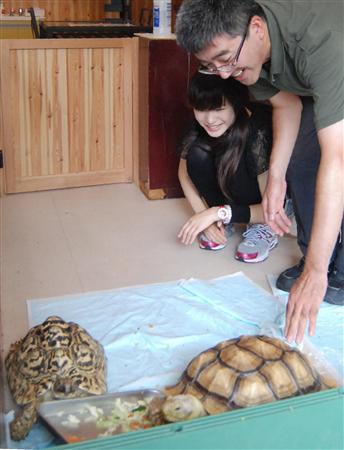 At the Yokohama Subtropical Tea Restaurent in Japan, reptiles aren't on the menu; they're staff.
It's a tea room for reptile lovers, and they have a mini zoo set up where people can get up close and personal with cold-blooded animals.
The 42-year-old Nagano opened Yokohama Subtropical Tea on the 4th of July and not only has his cafe proved popular, it's attracted an unexpected variety of customers, some of whom stay for up to 5 hours!
Nagano was also surprised to note that many of his customers were women who enjoyed talking about reptiles. One supposes that apart from the zoo, there weren't many places where reptilophiles (is that a word?) can go to share mutual interests... until now.
At present, Yokohama Subtropical Tea hosts as many as 30 different reptiles and amphibians including 11 different types of newts.
It also boasts a “free range” area at the back of the cafe where tortoises can roam about within a fenced area. Customers may touch the tortoises but afterwards are obliged to use the hand sanitizer on-hand, so to speak, for that very purpose.
For the full article, click here.
Wednesday, August 24 2011
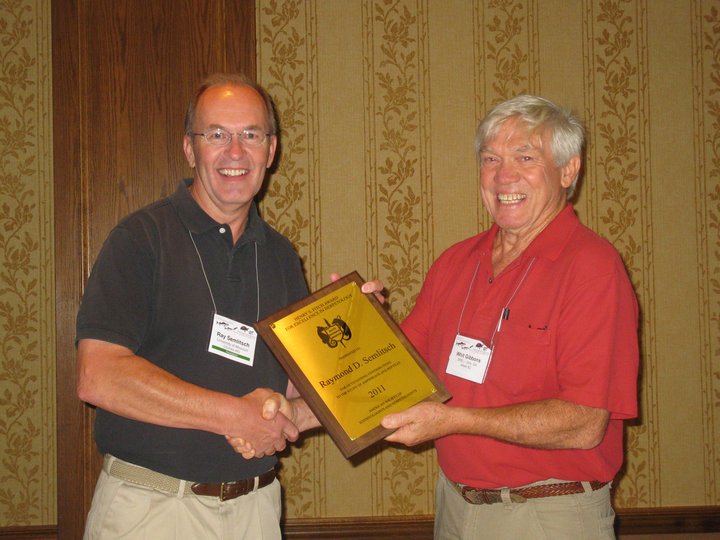 Congratulations to Ray Semlitsch on winning the 2011 Fitch Award for Excellence in Herpetology from the American Society of Ichthyologists and Herpetologists.
A leader of amphibian ecology and wetland conservation, Semlitsch is well-known for his research on the mechanisms of persistence of amphibian populations in altered habitats. His studies on the chemical contamination of farmlands have documented that tolerance to direct contaminants, such as insecticides, varies among species of amphibians, and that sub-lethal concentrations for amphibians have an indirect effect on food resources that cause mortality. He also established the ecological connection between aquatic and terrestrial environments for semi-aquatic amphibian species and defined the land around wetlands as an essential part of a species' "core habitat" and critical for management and protection.
"Dr. Semlitsch's research has spanned from basic ecology and life history evolution of amphibians to applied work on conservation of amphibians — work that will have a lasting impact on the way we will conduct science for years to come," said Michelle D. Boone, associate professor of zoology at Miami University, who nominated Semlitsch for the award.
Recently, he drew popular attention with research that showed that amphibian populations could thrive in properly buffered golf course ponds as well as in sustainably timbered forests.
To read the full article, click here.
Above photo taken from the University of Missouri College of Arts and Science facebook page. Ray Semlitsch, Curators’ Professor of Biology, receives the 2011 Fitch Award from J. Whitfield Gibbons, professor emeritus of ecology, from the Savannah River Ecology Laboratory.
Tuesday, August 23 2011
By
Tue, August 23 2011 at 17:35
Federal: Lake Erie watersnake no longer endangered
LAKE ERIE ISLANDS -- The Lake Erie watersnake, a nonpoisonous little fellow that slithers among a patchwork of islands in western Lake Erie, has been removed from the federal government's list of endangered and threatened species after a successful recovery campaign, officials said Monday.
http://www.thenews-messenger.com/article/20110817/NEWS01/108170306/Lake-Erie-watersnake-no-longer-endangered
OR: 4-H Champion Snake Stolen At County Fair
REDMOND, Ore. -- Unfortunately, the Deschutes County Fair wasn't all fun and games, especially for one young girl who got a rude awakening Friday morning.
http://www.ktvz.com/news/28795480/detail.html
NY: Pet store owner offers reward after burglary
Dominick Clemente has spent his life selling exotic animals, but he didn’t expect the jungle that his store turned into this weekend after someone broke in.
http://www.uticaod.com/latestnews/x655325859/Thieves-leave-paw-prints-all-over-pet-store-owner-offers-reward
HI: Illegal corn snake turned in to Hawaiian Humane Society
Someone turned a corn snake in to the Hawaiian Humane Society Sunday night under the state’s illegal animal amnesty program.
http://www.staradvertiser.com/news/breaking/Illegal_corn_snake_turned_in_to_Hawaiian_Humane_Society.html
MO: Exotic Animals, Excessive Noise Ordinances Approved by Hollister Aldermen
Hollister aldermen have given first-round approval to a couple of bills pertaining to exotic animals and excessive noise. The laws require permits and fees for the housing of exotic animals, and impose penalties for noise emissions that exceed 75 decibels. The law would affect residents and businesses that house animals like monkeys, tigers, wolves, alligators and venomous snakes that can attain a length of 8 feet or longer.
http://hometowndailynews.com/6944/exotic_animals_excessive_noise_ordinances_approved_by_hollister_aldermen_.html
AZ: Reptiles rescued from hoarder in northern Arizona
SCOTTSDALE, Ariz. - Seven reptiles, including snakes up to 16 feet long, have been rescued from a home in northern Arizona.
http://www.azfamily.com/news/local/Reptiles-rescued-from-hoader-in-northern-Arizona-128226878.html
Sunday, August 21 2011
This weekend, the chondros are the hot ticket. Each time I saw any at a table, by the time I made it back for photos, they were cleared out. And I can see why:
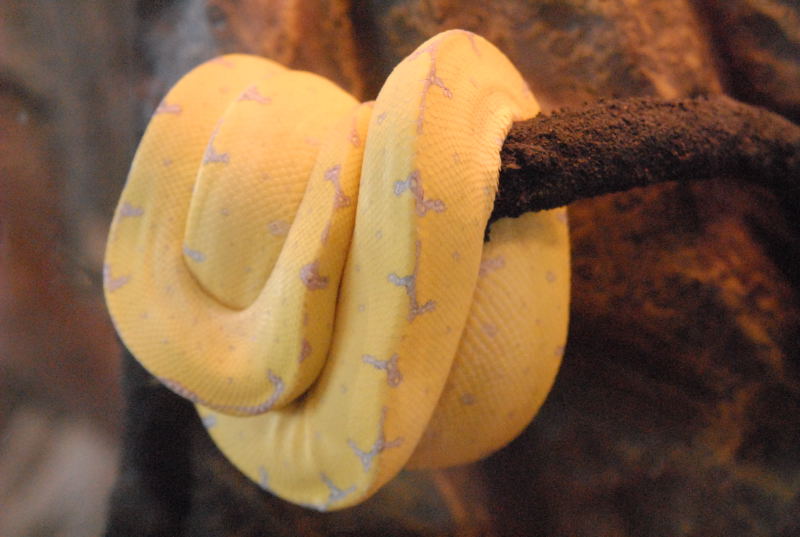
The days are long at NRBE, and we tend to get a bit punch-drunk, but seriously, a lizard giving advice, Thushara? Maybe he's just telling you he needs a Power Sun for the weekend?

Saturday, August 20 2011
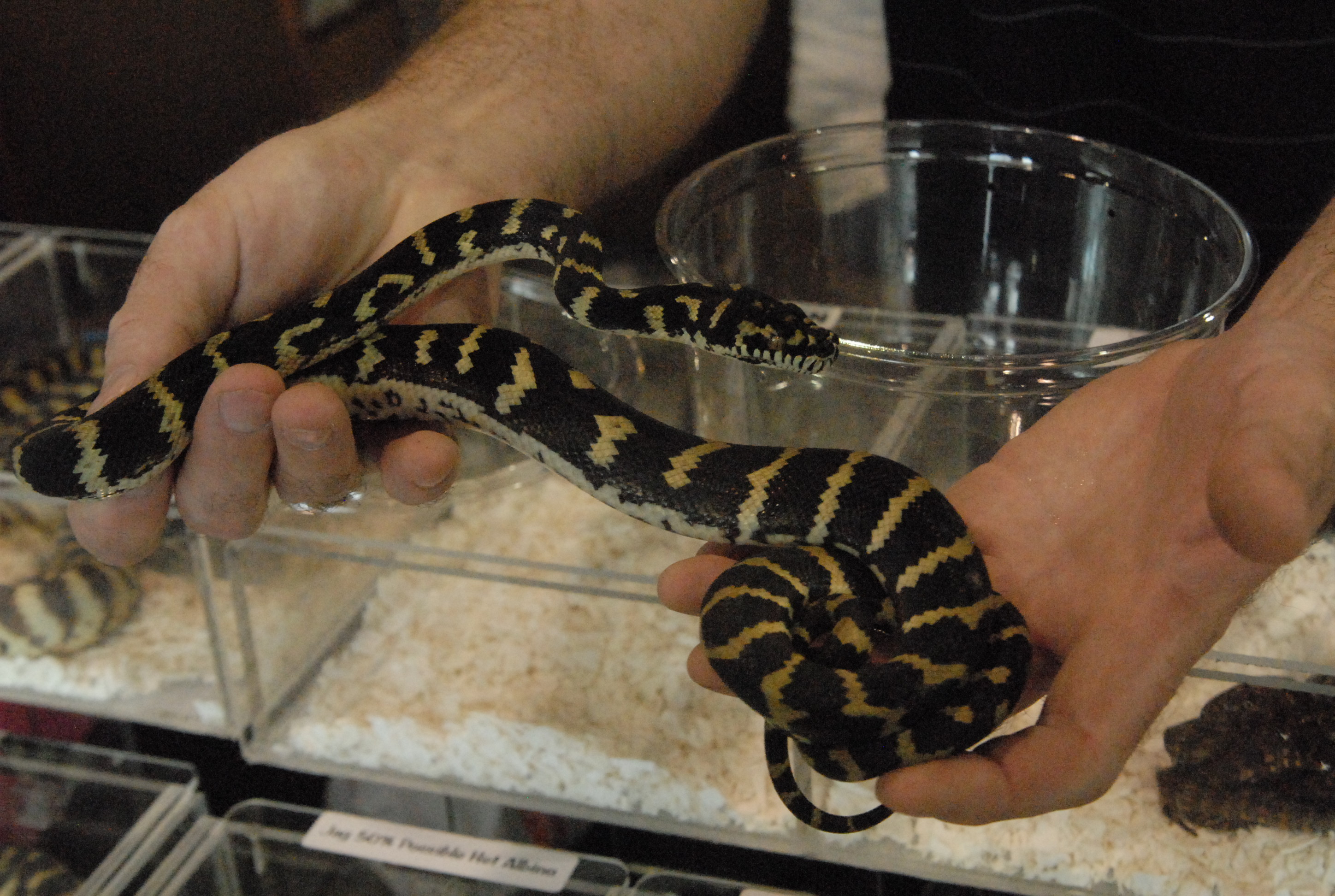 I spent the day stalking Tom Keogan's booth at the National Reptile Breeders' Expo here in Daytona.
Forum regulars know Tom breeds an wide selection of pythons. I finally got close enough to drool over his fabulous captive bred white lip pythons, got him to promise to give me time to chat in the morning, and then he pulled out the stunning Coelens. Yeah, it's a hybrid, but dang, it's pretty.
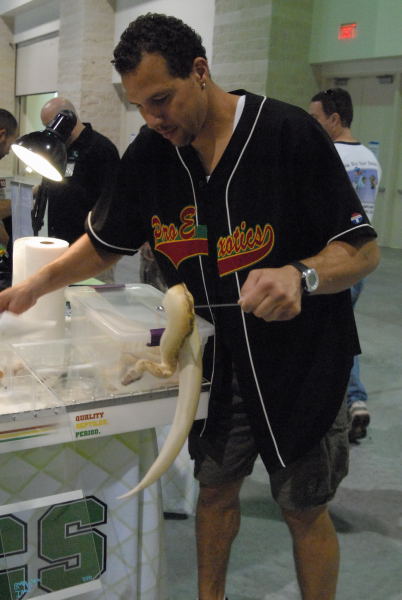 It's a dirty job, but someone has to do it. I'm talking about what goes on behind the scenes at the National Reptile Breeders' Expo, where the reality is anything but glamorous.
Just ask Chad Brown of Pro-Exotics. Here he is holding one of the most notorious of all poo-ers. Gotta love them blood presents.
So next time you wish you were part of the parties and wild times you imagine happen behind closed doors at the show, you might want to wish for something else.
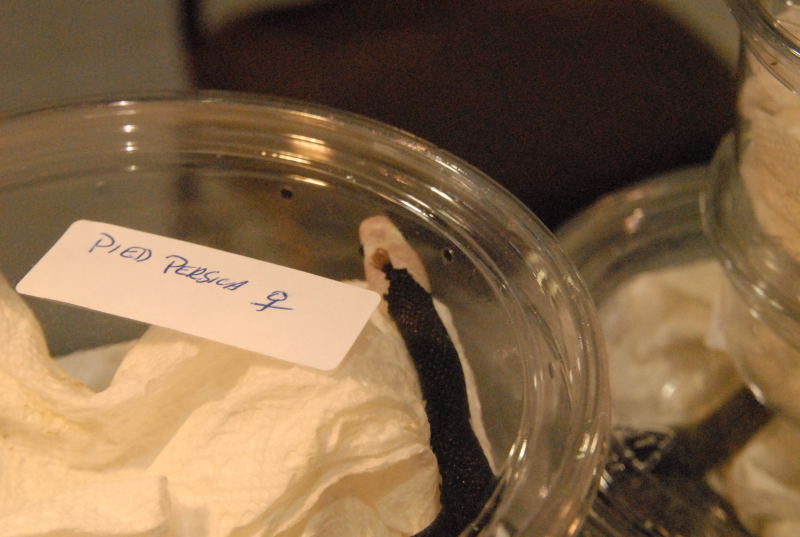 This morning I took a more leisurely walk through the exhibit hall than I was able to last night.
It took me almost an hour to complete the first aisle alone. Shawn Heflick's albino gators grabbed me each time I walked past their unbelievable cuteness.
Those who know me will find it amazing that it was not a python that also caught my eye. The cute little head of this pied Persica made me stop, turn and double back. Yep, I thought a colubrid was cute! I also think one of the leopard geckos I passed was flirting with me. Every time I turned to look, he would come to the front and smile at me.
A few photos after the bump, and you can find -- and upload! -- more in the kingsnake.com NRBE 2011 photo gallery.
Continue reading "NRBE: Saturday morning bling"
All I have to say is, either the door is going to be huge this year or everyone wanted to be there the minute it opened.
I don't recall this many people lined up for opening day in a few years, so it is great to see everyone turn out! Here are some shots looking one way down the corridor...

And the other:

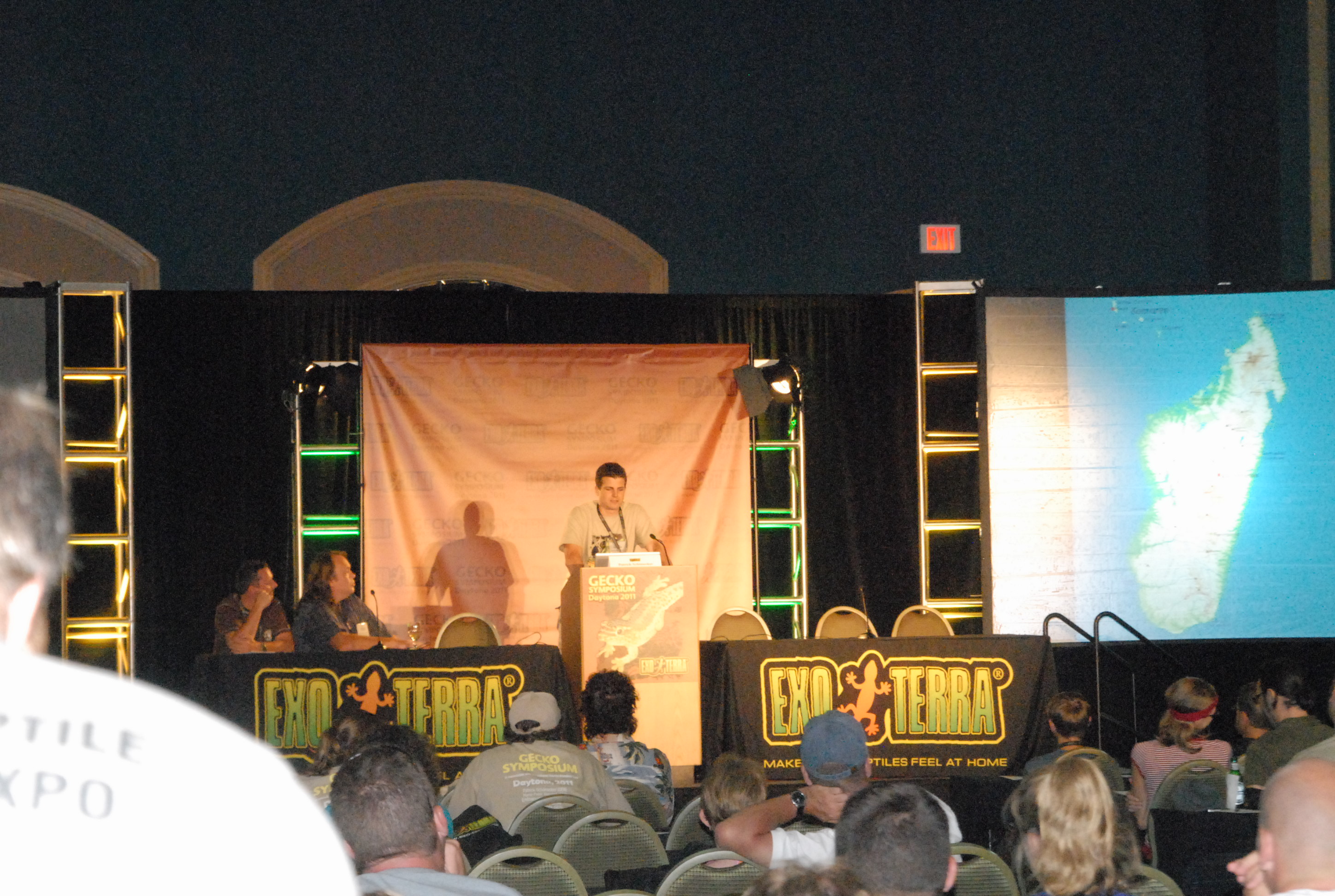 After arriving at the National Reptile Breeders' Expo in Daytona, I spent some time walking around the exhibit hall and hitting the talks.
I had so much trouble deciding which talk I wanted to go to, that I ended up bouncing between all three: the annual turtle talks, which are a regular hit and very popular; the boa talks along with a legal chat by Bill Brant, Dave Barker and Andrew Wyatt; and the Gecko Symposium.
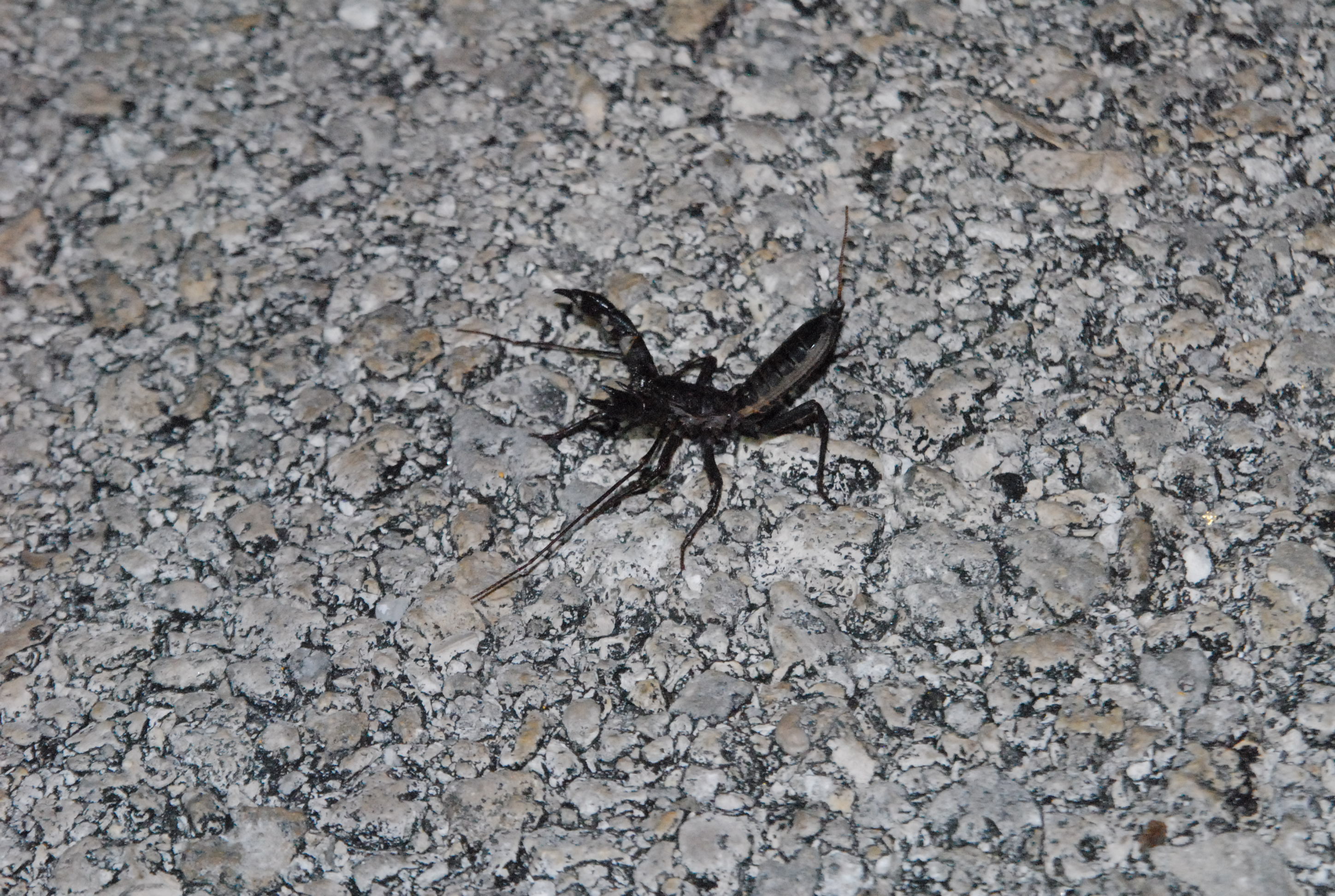 Afterward, Chris Law and I hooked up with Jason Hood, a friend from the Chicago Herp Society, for what we had hoped would be a night of herping.
But sometimes all you do is hope. A Vinegaroon later, we came up pretty with nothing more than a bunch of frogs bopping across the road. But hey, we hung out and I tested out my brand spanking new headlamp.
Maybe where we went wrong was I was actually prepared. Usually I have nothing more than my wits. This time I had everything: collapsible hook, flashlights, headlamp, and good friends. I guess I'll try leaving something behind next time -- but definitely not the friends!
Friday, August 19 2011
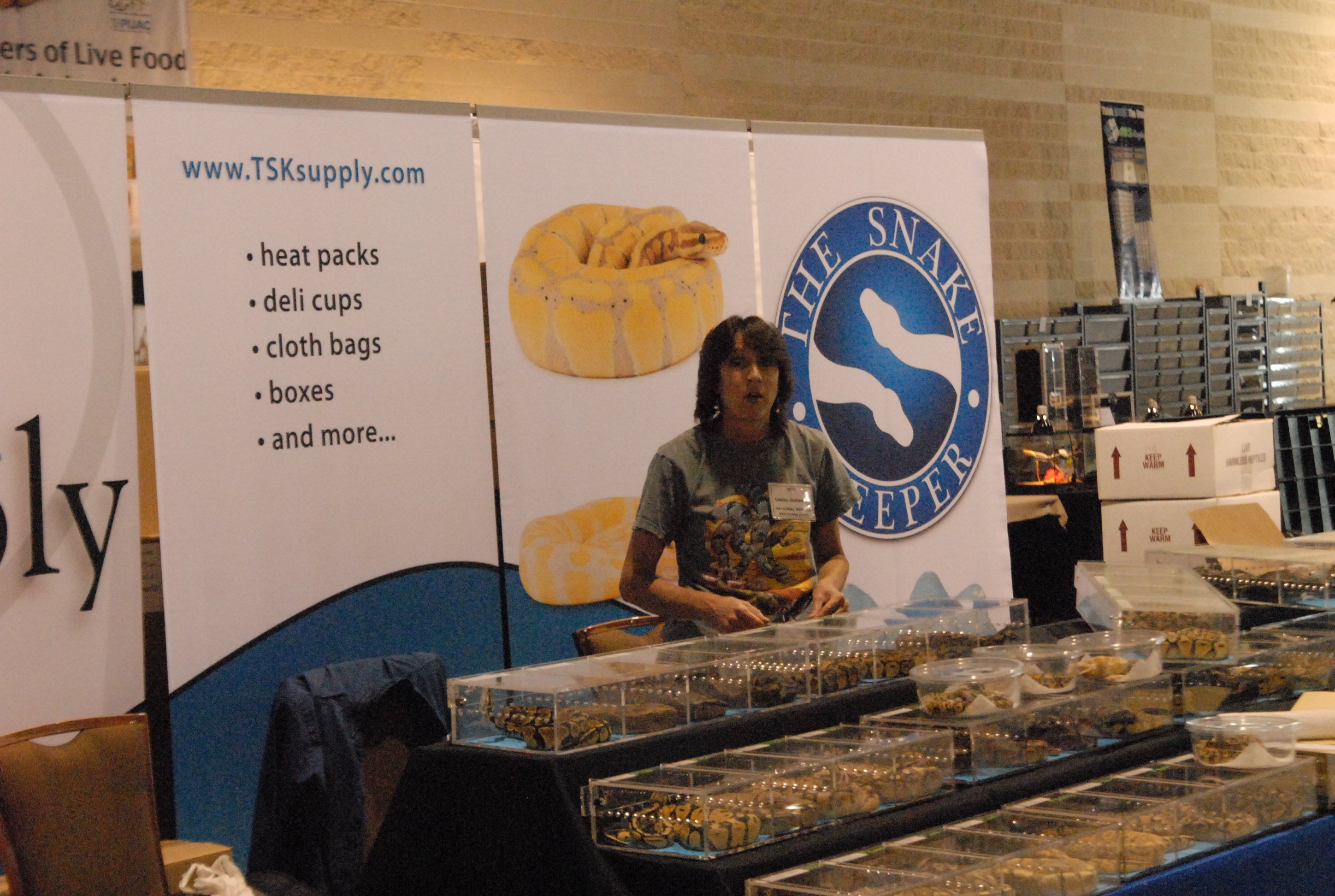 I've finally arrived at the National Reptile Breeders' Expo. After getting delayed for an eternity by Delta in Atlanta, I rolled into the Hilton two hours late. Thanks to my driver and partner in crime for the day, Chris Law, I had a ride waiting for me. Check in and lunch at the Hog Wild BBQ then off to set up.
First in the door I got to see one of my favorite gals, Collette Sutherland. We had a meeting as to why herper girls rule. The reason? Because we are girls.
Set-up was pretty much done, but I did get to chat with Jeff Clark for quite sometime. We talked about a lot of the changes from over the years that we have seen. Changes in how people start, how they learn and what we have seen over the years. I felt like an old-timer here.
Here are a few shots of some stuff that I get excited about to tide ya over, under the bump. Tonight I am heading into the talks for a bit and then Chris and I are hooking up with some other friends and hitting the pavement. I am becoming a real herper; I remembered to pack flashlights and my brand spanking new headlamp!
Continue reading "NRBE: Friday set-up - and why girls rule"
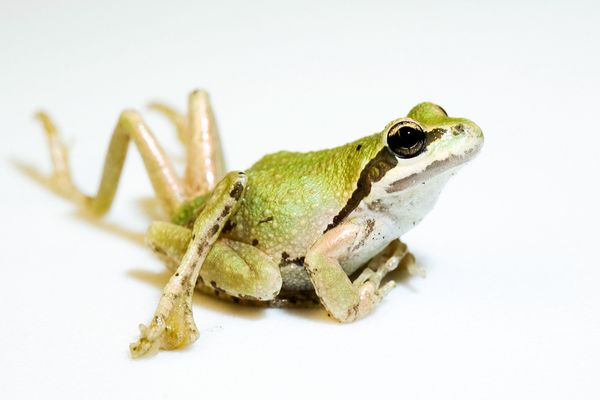 The flatworm parasite, Ribeiroia ondatrae, has been known for a decade to cause deformities. While distribution is not spreading, the location of this parasite in monitored sites has moved.
"We found that, although the distribution of Ribeiroia across wetlands changed, there was little net effect on overall parasite prevalence, with 31 percent of wetlands gaining the parasite and 27 percent losing the parasite," according to the study.
But "what was most intriguing," Johnson said, "was that the locations of hot spots had changed substantially over the last decade."
For instance, ponds where scientists had found few "grotesque" frogs in 1999 now had 30 percent or more frogs with deformed limbs, he said. Likewise, former hot spots now had fewer of the diseased amphibians, according to their results, which are not yet published in a journal.
Because some of the hot spots can house threatened or endangered amphibians, conservationists need to know where the parasite is moving.
Predicting future hot spots by keeping track of environmental factors—for example how land is used—may also help scientists figure out what's happening to amphibian populations.
"These severe malformations—even though it's not in the headline news—these continue to occur in a lot of amphibian populations in the western U.S.," said Johnson, who received funding from the National Geographic Society's Committee for Research and Exploration. (The Society owns National Geographic News.)
To read the full article, click here.
Wednesday, August 17 2011
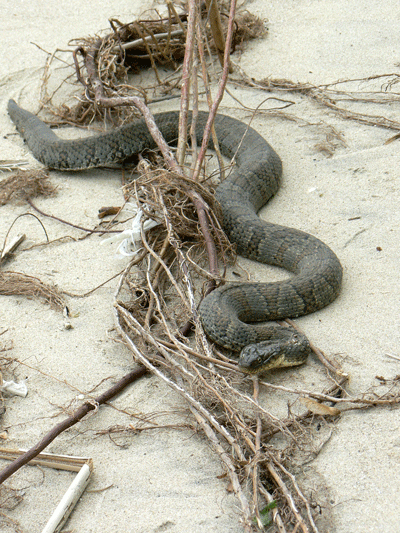 Much like the American Alligator, the Lake Erie watersnake ( Nerodia sipedon insularum) is no longer teetering on the brink of extinction.
The Lake Erie watersnake population had declined to about 1,500 adults by the mid-1990s because of human persecution and habitat loss from shoreline development. Federal and state agencies designated 300 acres of inland habitat and 11 miles of shoreline as breeding and hibernation grounds, while scientists led a public relations blitz to convince people the snake was nothing to fear.
The effort quickly paid off. By 2002, the snake had reached the government's minimum goal of 5,555 snakes. A census in 2009 estimated the population at nearly 12,000.
[....]
Exotic species generally are regarded as harmful to ecosystems they invade. The round goby has caused a number of native Great Lakes fish to decline. But it arrived just in time for the watersnake.
"This is an ironic example of where an invasive species actually helps fuel the recovery of an endangered native species," said Kristin Stanford, a Northern Illinois University researcher who also works for Ohio State University's Stone Laboratory on Lake Erie's Gibraltar Island. "Within the past decade, watersnakes are now growing faster, bigger, with more offspring and a higher survival rate."
To read the full article, click here.
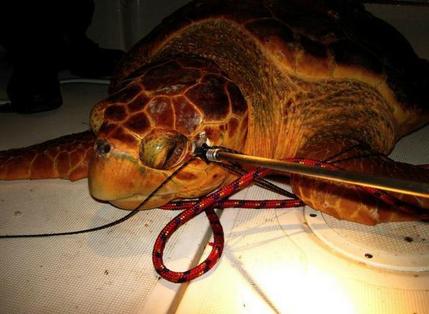 Beating all odds, this Loggerhead turtle is recovering nicely after being shot in the head with a spear and with the help of community outcry, perhaps the culprits will be caught. An increasing reward is being offered and currently sits at $10,750 cash and other items offered by community members.
"The whole community is so up in arms about it," said Richie Moretti, who founded the Turtle Hospital in Marathon in 1986.
The victim is a sub adult, 15 to 18 years old. Although the turtle is too young for its gender to be determined, its rescuers named it Sara, after a family member who was celebrating her 18th birthday.
Doug Mader, an expert reptile veterinarian who removed the four-foot, steel-shafted spear, said Sara is one lucky turtle.
The story began on Aug. 3, when father and son Charlie and Nicholas Borg, vacationing from Michigan, were returning to Big Pine Key from a fishing trip in the Atlantic. They spotted something floating, with flippers in the air, near Little Palm Island.
As they got closer, they discovered it was a sea turtle with a long spear protruding from its face. "I've seen turtles before that were hit by boats, but that was not anything I expected to see," said Nicholas Borg, 22.
"At first we thought it was dead, but it pulled its head up, took a breath and dove back down," he added. "We both looked at each other and knew we needed to do something."
[....]
He expects that Sara will be well enough to be released back into the wild within a month or so.
"I don't think it will have any permanent injuries, just a great story to tell its kids," Mader said.
To read the full article. click here.
By
Wed, August 17 2011 at 18:13
Federal: No federal protection for gopher tortoises under Endangered Species Act
MOBILE, Alabama — Gopher tortoises living east of the Tombigbee River deserve protection under the Endangered Species Act but will not get it because listing the species would cost too much and draw resources away from other threatened animals, federal officials said Tuesday morning.
http://blog.al.com/live/2011/07/no_federal_protection_for_goph.html
MD: Baltimore City Council wants say on school board members
Councilman Robert Curran introduced what he calls an overhaul of the city's animal control regulations. The bill appears to broaden the scope of potential violations and extends regulations to exotic and farm animals, though the proposed changes would not increase existing fines and penalties.
http://www.baltimoresun.com/news/maryland/bs-md-animal-regulations-20110815,0,1477557.story
AR: Crittenden County couple faces 41 counts of animal cruelty
PROCTOR, AR (WMC-TV) - A Mid-South couple faces 41 counts of animal cruelty after investigators made a shocking discovery.
http://www.kait8.com/story/15274212/crittenden-county-couple-faces-41-counts-of-animal-cruelty
NC: Police arrest man who possessed dozens of venomous snakes
Police arrested snake owner Walter Clarence Kidd, 51, Monday night on charges that he illegally possessed venomous reptiles at his home at 65 Doe Trail, Hendersonville.
http://www.blueridgenow.com/article/20110816/NEWS/110819824/1008/SPORTS?Title=Police-arrest-man-who-possessed-dozens-of-venomous-snakes
Northern Mariana Islands: Court accepts guilty plea in turtle poaching case
A man accused of poaching a green sea turtle in 2010 pleaded guilty Tuesday as part of a plea deal and was sentenced to six months in prison, all suspended except for three months.
http://www.saipantribune.com/newsstory.aspx?newsID=111919&cat=1
NY: Vanishing turtles and fish at Bowne Park pond stir up poaching fears among residents
Local residents say turtles that live in the park's pond have been disappearing at an alarming rate and that the park's fish population also has plummeted.
ttp://www.nydailynews.com/ny_local/queens/2011/08/17/2011-08-17_vanishing_park_turtles_fish_stir_poach_fears.html
Tuesday, August 16 2011
By tskinc
Tue, August 16 2011 at 20:09
YES! once again we are going to be hatching out piebald clowns. Not sure how many are in the eggs but we are hoping for a few of them. This is only the second time piebald clowns have been hatched out. So this is a new morph that is sure to be the favorite of many. Stay tuned tomorrow for an update if we can see what is in the egg before we leave to Daytona for the big show.
Monday, August 15 2011
 Despite the fact that Florida is a battle ground for invasive pythons, thousands of reptile owners are preparing to land en masse there over the next few days.
To the reptile community, Daytona is the Mecca of our journey. Our very own forums here at kingsnake.com, Facebook and Twitter are buzzing with folks planning to meet up. With our community spread far and wide, this is the one time we often get to meet our "friends."
We'll be enjoying the chance to bring the show to those not able to be there. And if you are at the show, we will keep in touch with you as well. Live blogs of the talks, photos from the show floor, interviews with vendors and attendees as well as taking you along on any herping trips will all be happening.
A few ways to keep up with us this week are listed after the bump.
Continue reading "Daytona: kingsnake.com covers The National Reptile Breeders' Expo 2011"
Friday, August 12 2011
By
Fri, August 12 2011 at 14:25
New Rosy Book! Rosy Boas Patterns in Time. We have been waiting for this for a long time.
http://beanfarm.com/product_info.php?products_id=6064
Rosy Boas, Patterns in Time
Rosy Boas: Patterns in Time is the first book to depict 60 forms of the Rosy Boa that are found naturally in California, Arizona, and Mexico. It also includes 60 habitat images of where these animals occur in the wild, along with a range map where the four major naturally occurring groups of Rosy Boas can be found. The numerous morphs found in captive propagation programs are also dazzlingly displayed in their full beauty. Step-by-step procedures to successfully keep these wonderful animals in captivity are also detailed. The authors have over 100 years of combined experience working with these snakes. The techniques outlined for successful maintenance and captive propagation is the result of these many years of experience. This is the only book you'll need to learn how to keep these wonderful pets. 2011, SC 184 pgs. $29.00
Thursday, August 11 2011
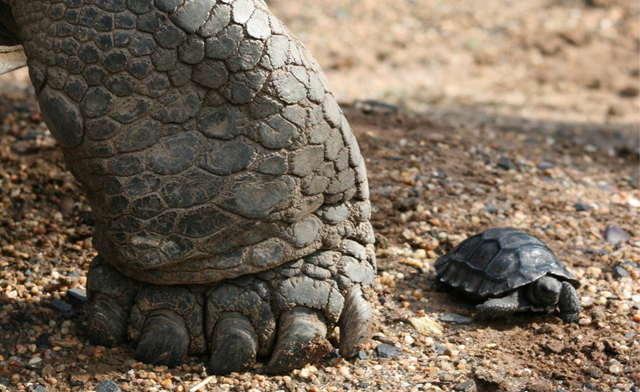 A Galapagos tortoise at the Dubbo Western Plains Zoo became a first-time mother and, as you can see by this pic, created one of the most adorable shots ever!
Slow to get started but T3 the tortoise is a mum at age 90.
And Galapagos tortoise T3 is also a cougar: the two possible fathers at Dubbo Western Plains Zoo are 40 and 41. It is the first time a Galapagos tortoise – the fifth longest-living animals in the world, with some being recorded as reaching 177 years of age – has been bred in captivity in Australasia.
T3′s baby, named NJ, will be alive long after every keeper, and the youngest human visitor to Dubbo Western Plains Zoo, has passed away.
For the full article, click here. Video after the bump.
Continue reading "Galapagos tortoise becomes first-time mother at ninety"
Wednesday, August 10 2011
Kyle and I shot a video clip of my original "Karma" female wrapped around a pile of eggs.......10! It seems like just yesterday when she first emerged from her egg....wayyyy back in 2003 clutch # 14.
2003 clutch # 14
2011 clutch # 51 - Karma on eggs
Tuesday, August 9 2011
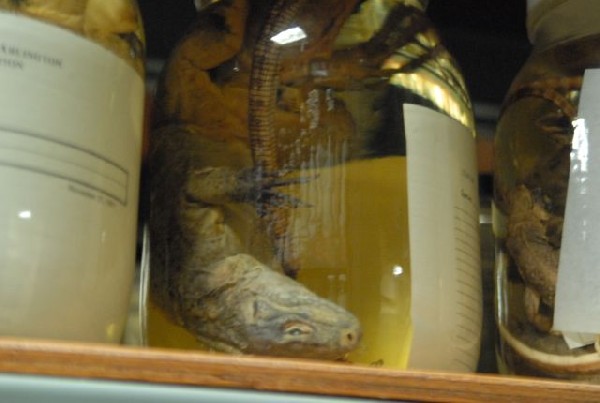 One of the most interesting parts of any conference are the field trips away from the actual talks. At the International Herpetological Symposium, I was left in hysterics over one of them. Really, how many other groups would go on a field trip to look at dead things in jars? But for reptile folks, it just seems normal.
Stopping by Carl Franklin's office at the University of Texas - Arlington to see the state's largest specimen collection was definitely interesting. There were a few species I saw that I dont believe I would have seen alive. Carl has a great sense of humor and I will deeply regret missing him speaking at the Chicago Herpetological Society in August. The collection is used nationwide by researchers to learn more about genetics, locality specific data, taxonomy and much more.
After our visit with Carl, it was time for lunch. Dead things, check. Food and drink, check. Live things? Those, too.
Lunch was a trip to the Dallas World Aquarium. After we ate, we headed to the third floor and worked our way down. The aquarium is set up as a descending spiral that brings you different regions as you go. Not just fish, there a selection of mammals, birds and reptiles. Knowing our group, we could not contain ourselves walking through and educating along the way.
I'm telling ya, the Aquarium should have paid us for that day. Every step of the way, all members of our group worked with the general public on reptiles primarily, but everything we knew about. Our little community of gypsies is kinda cool after all. As the day wound down, we headed back to the hotel for the ice breaker party and to prepare for a day of talks.
Photos after the bump.
Continue reading "Field trip to UTA and the Dallas World Aquarium"
Monday, August 8 2011
By
Mon, August 8 2011 at 10:28
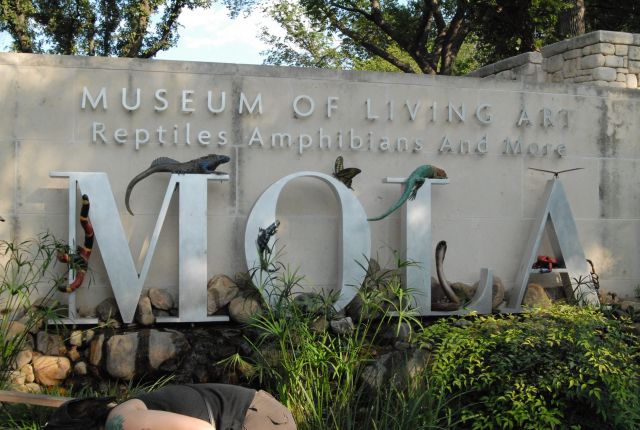 The Fort Worth Zoo was the host facility for this year's International Herpetological Symposium, and while I know they have lions (could hear them roaring) I saw little else. However, what I did see mattered: "The Museum Of Living Art." What better name to give to a reptile facility?
Upon arrival, we grabbed drinks and ran like school kids through the exhibits, jostling to see who could take a picture first. The zoo was closed to the public, so we were not on our best behavior, which made it a bit more fun.
After the random scattering, we all sat down to a barbeque dinner overlooking the lovely Gharial exhibit, and watched a the female come right to our side of the enclosure. The closer the animal got, the less people were concerned with food and the more of us scooted over to the glass to shoot pics.
After dinner, the back of the building was opened. MOLA itself is huge for a reptile exhibit, but the back seemed like a giant labrynth. Rooms set up for each grouping of species and set to the species of those animals -- a tortoise room, amphibian room, more rooms, and a room that held several Boelen's Pythons.
Hard as I tried, those cages would not open, nor would Ari look away. But I guess I made his night when the excitement of what was in the cages hit me; when I'm excited I not only squeal, but I make great faces.
Another highlight there for me was the Ctenosaura bakeri, Utila Island Iguana. This was the project that first got me involved with conservation issues and the folks who are the driving force behind the International Reptile Conservation Foundation.
Photos from the night after the bump.
Continue reading "IHS Dinner at Museum of Living Art"
|


